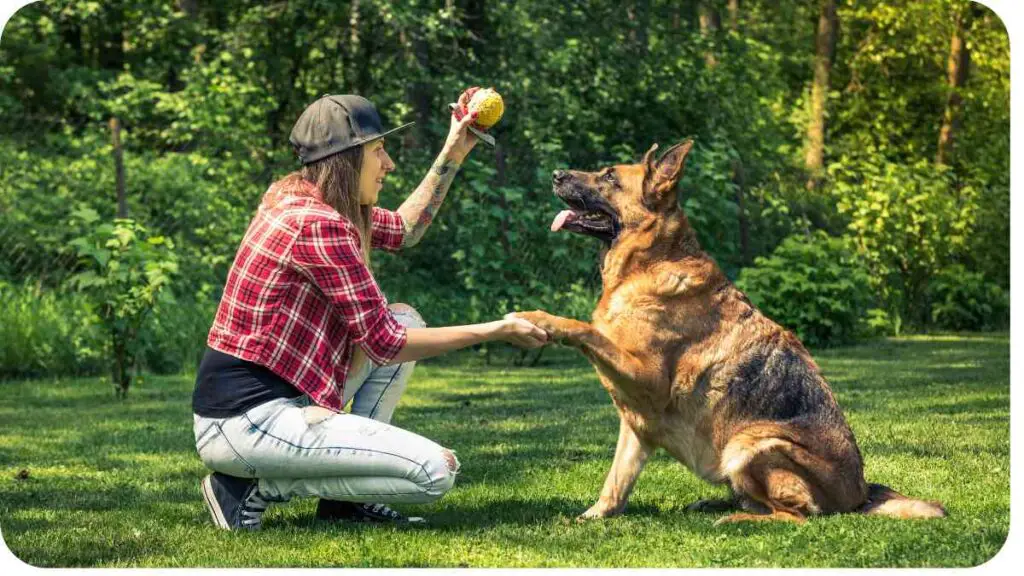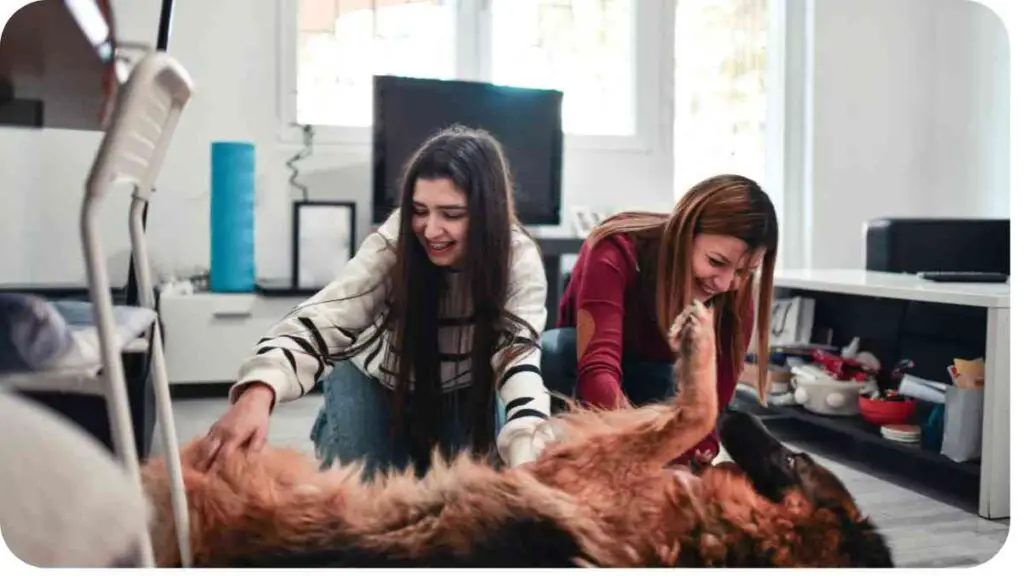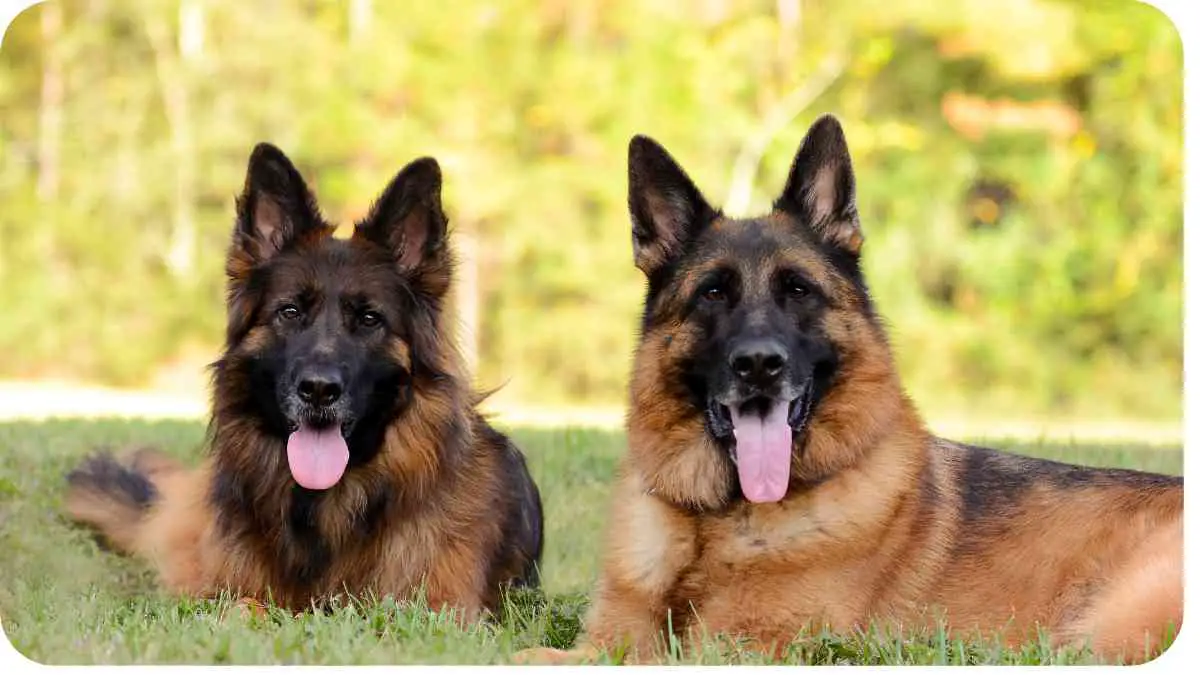Introducing yourself to a German Shepherd can be a pivotal moment in building a strong bond with these intelligent and loyal dogs. However, it’s crucial to approach the introduction with care and understanding of the breed’s behavior and temperament.
| Takeaways |
|---|
| Approach German Shepherds calmly and confidently. |
| Use positive reinforcement, such as treats, to build trust. |
| Respect the dog’s boundaries and allow it to initiate contact. |
| Be patient and consistent in your interactions. |
| Supervise introductions to other pets carefully. |
2. Understanding German Shepherds

German Shepherds are known for their intelligence, loyalty, and protective nature. They are often used as working dogs in various roles, including police and military work, search and rescue, and as service animals. These dogs have a strong instinct to protect their territory and loved ones, making proper introductions essential.
Introducing your German Shepherd to other dogs requires patience and understanding. Establish a gradual introduction process to ensure a harmonious relationship.
3. Why Proper Introduction Matters
A proper introduction sets the tone for future interactions and can help establish trust and respect between you and the German Shepherd. It can also prevent misunderstandings or fear-based reactions from the dog, ensuring a positive and harmonious relationship.
4. Preparing for the Introduction
Table: Essential Items for Introduction
| Item | Description |
|---|---|
| Leash and Collar | Provides control and safety during the introduction. |
| Treats | Used for positive reinforcement and building rapport. |
| Comfortable Clothing | Wear attire that allows freedom of movement and comfort. |
Before approaching a German Shepherd, gather the necessary items to ensure a smooth and successful introduction.
Babies and German Shepherds can form strong bonds, but proper supervision and gentle interactions are key for a safe and happy coexistence.
5. Approaching a German Shepherd
Approaching a German Shepherd should be done calmly and confidently. Avoid sudden movements or loud noises that may startle the dog. Maintain a relaxed posture and avoid direct eye contact, as this can be perceived as a challenge.
6. Body Language and Tone of Voice
Your body language and tone of voice play a crucial role in how the German Shepherd perceives you. Stand tall with relaxed shoulders and avoid tensing up. Speak in a calm, friendly tone to convey a sense of reassurance and trust.
7. Offering a Hand for Sniffing

Once you’re within a comfortable distance, offer your hand for the German Shepherd to sniff. Allow the dog to approach you at its own pace and avoid reaching out abruptly. This gesture allows the dog to gather information about you through scent, an important part of canine communication.
When introducing a German Shepherd to cats, consider their personalities and gradually introduce them in a controlled environment to foster positive associations.
8. Using Treats for Positive Reinforcement
Table: Recommended Treats for Introductions
| Treat | Description |
|---|---|
| Small, Soft Treats | Easy to chew and swallow quickly. |
| High-Value Treats | Irresistible treats for extra motivation. |
| Healthy Options | Low-calorie treats for frequent use. |
Offering treats is an effective way to establish a positive association with you. Start with small, soft treats and gradually introduce higher-value treats for reinforcement.
9. Allowing the Dog to Initiate Contact
Once the German Shepherd has had a chance to sniff your hand and is comfortable, allow the dog to initiate contact if it chooses to do so. This may involve the dog nudging your hand or leaning against you. Respect the dog’s boundaries and avoid forcing physical contact.
10. Building Trust and Rapport
Building trust and rapport with a German Shepherd takes time and patience. Use positive reinforcement techniques, such as praise and treats, to reward desirable behaviors. Spend time bonding with the dog through play, walks, and training sessions to strengthen your relationship.
While German Shepherds enjoy outdoor time, ensure their safety and well-being by understanding the appropriate duration for outdoor activities to keep them happy and healthy.
11. Common Mistakes to Avoid
Table: Mistakes to Avoid During Introduction
| Mistake | Description |
|---|---|
| Approaching Aggressively | Can trigger fear or defensive reactions in the dog. |
| Making Sudden Movements | May startle the dog and lead to a negative response. |
| Ignoring Warning Signs | Failure to recognize signs of discomfort or aggression. |
| Overwhelming with Attention | Too much attention can be overwhelming for the dog. |
Avoid these common mistakes during the introduction process to ensure a positive experience for both you and the German Shepherd.
12. Patience and Consistency
Patience and consistency are key when introducing yourself to a German Shepherd. Every dog is different, and it may take time for the dog to feel comfortable around you. Be patient and consistent in your approach, and allow the relationship to develop naturally.
13. Introducing Other Family Members

Once you’ve established a bond with the German Shepherd, introduce other family members using similar techniques. Encourage them to approach calmly and offer treats as a positive reinforcement. Supervise interactions to ensure everyone’s safety and comfort.
14. Introducing to Other Pets
Introducing a German Shepherd to other pets should be done gradually and under controlled circumstances. Start by allowing them to sniff each other through a barrier, such as a baby gate, before progressing to supervised interactions. Reward positive interactions with treats and praise.
15. Conclusion
Introducing yourself to a German Shepherd is an important step in building a strong and trusting relationship with these remarkable dogs. By understanding their behavior, using positive reinforcement techniques, and approaching with patience and consistency, you can create a positive and lasting bond that enriches both your lives.
Remember to respect the dog’s boundaries and allow the relationship to develop at its own pace. With time and effort, you’ll soon become fast friends with your German Shepherd companion.
Further Reading
- The Right Way to Introduce Yourself to a New Dog: This blog post provides detailed tips and techniques for introducing yourself to a new dog in a safe and respectful manner.
- How to Introduce Yourself to a Dog: Lifehacker offers practical advice on how to approach and introduce yourself to a dog, emphasizing the importance of body language and respect for the dog’s space.
- Correct Way to Approach a GSD: This forum thread discusses the correct approach to a German Shepherd Dog (GSD) and shares insights from experienced GSD owners.
FAQs
How should I approach a German Shepherd for the first time?
Approach the German Shepherd calmly and confidently, avoiding sudden movements or direct eye contact. Allow the dog to sniff your hand before attempting any physical contact.
What should I do if a German Shepherd seems hesitant or wary of me?
If a German Shepherd appears hesitant or wary, give the dog space and avoid imposing yourself. Speak softly and move slowly to avoid escalating the dog’s anxiety.
Is it safe to offer treats during the introduction?
Yes, offering treats can be an effective way to build a positive association with you. Choose small, soft treats and offer them as a reward for calm behavior.
How can I tell if a German Shepherd is comfortable with me?
A comfortable German Shepherd may exhibit relaxed body language, such as loose posture and wagging tail. They may also approach you willingly and show interest in interacting with you.
What should I do if a German Shepherd shows signs of aggression during the introduction?
If a German Shepherd displays signs of aggression, such as growling or baring teeth, back away slowly and avoid confrontation. Seek assistance from a professional dog trainer or behaviorist for guidance on handling aggressive behavior.

I’m Dr. Hellen James, I’ve spent my career working with dogs, and I’ve seen first-hand how important it is to understand the individual needs of each breed. I want to share my knowledge of dog breeds with you so that you can make informed decisions about which dog will be best for your household and lifestyle.

